Sun City Girls Discographical Dossier
What more can be said at this point about Sun City Girls, more than 15 years since the death of drummer Charles Gocher in 2007 brought the band to an end? What more can I say? Given that I did long (very long!) "Correspondence" interviews with the other two-thirds of the band, the brothers Alan and Richard Bishop, in 2006 and 2011, respectively. The answer: probably a lot more about specific recordings, since there are so many of them (and presumably archival releases are still to come, not to mention albums by Alvarious B—Alan's solo moniker—and Sir Richard Bishop and other projects the two are involved in). The more obscure the better, I suppose, but that approach is not mine. When we want to listen to a great deal of music, across wide swaths of genre, origin, and taste, we may end up eschewing the obscure, no matter what treasures other enthusiasts insist await us, and opt instead for samplings, in this case the band's best albums, in addition to notes about larger facets of their body of work.
Torch of the Mystics, Torch of the Mystics, Torch of the Mystics... we may want to recite it more because countless casual listeners out there in Rock/ Indie land have likely listened to it 10 or 20 times as often as they have anything else put out by Sun City Girls. To be fair, while the earlier Grotto of Miracles already showed the band capable of making a great album (though one that in retrospect seems timid), Torch of the Mystics is "something else all together," the one "where everything came together," their peak, a masterpiece... some phrasing like that which makes the writer feel that he is is an A. I. idiot. But seriously, it is Rock Top Ten territory: Revolver, Low, Daydream Nation, whatever your drug of choice. Alan Bishop as a vocalist "comes into his own"—there goes that A. I. again!—his performances on ‘Space Prophet Dogon’ and ‘The Flower’ are marvels, his voice at this point in his life a force of nature. Let's just stop at this point lest more clichés surface. Meanwhile, from the opening track, ‘Blue Mamba’, onward, Richard Bishop established himself as arguably the finest guitarist working in Rock music at the time, both exploring distortion-as-timbre, "alternate" tunings, and electroacoustic effects as much as the Indie stars of the time (Sonic Youth, Fushitsusha, the Dead C) and having traditional "chops," not to mention an appreciation of varied folk and foreign techniques unmatched by his peers.
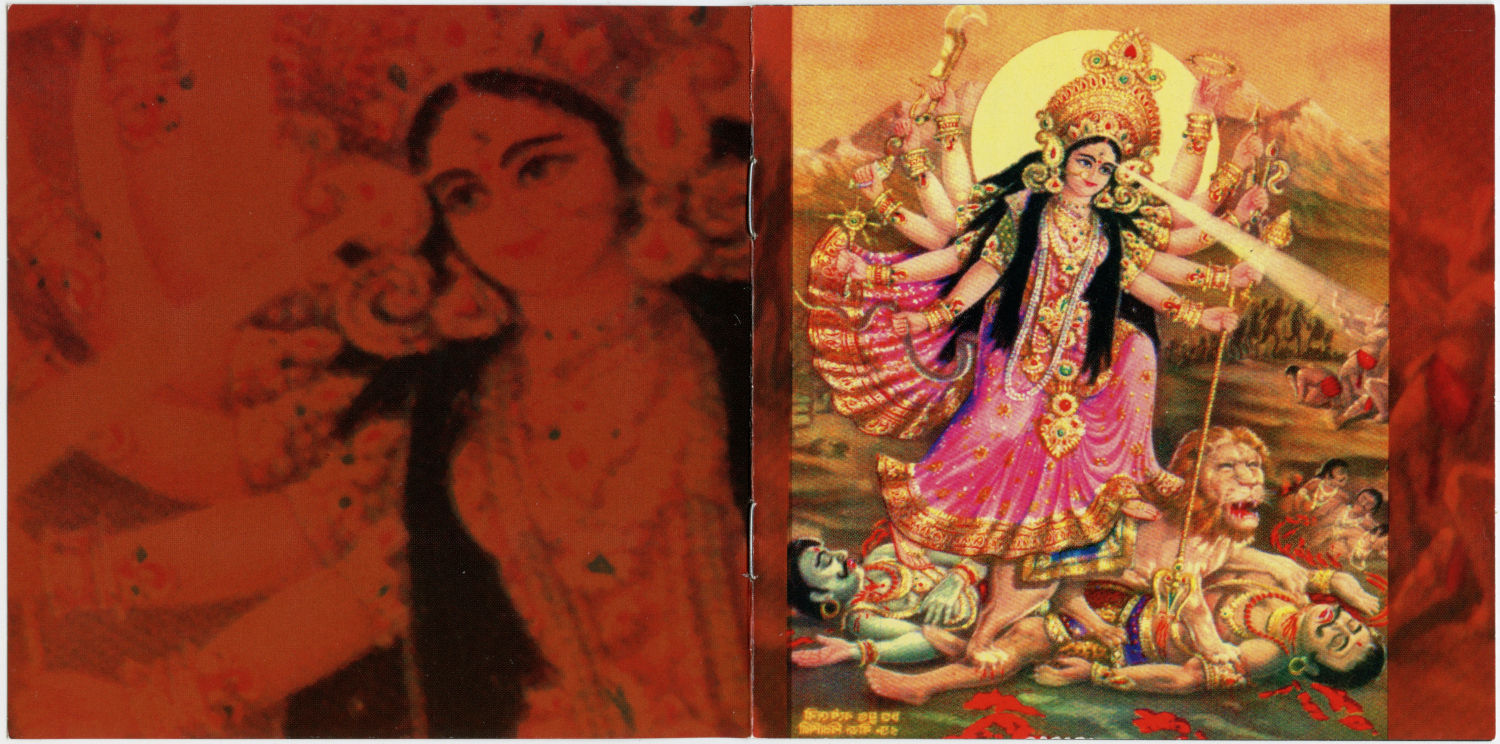
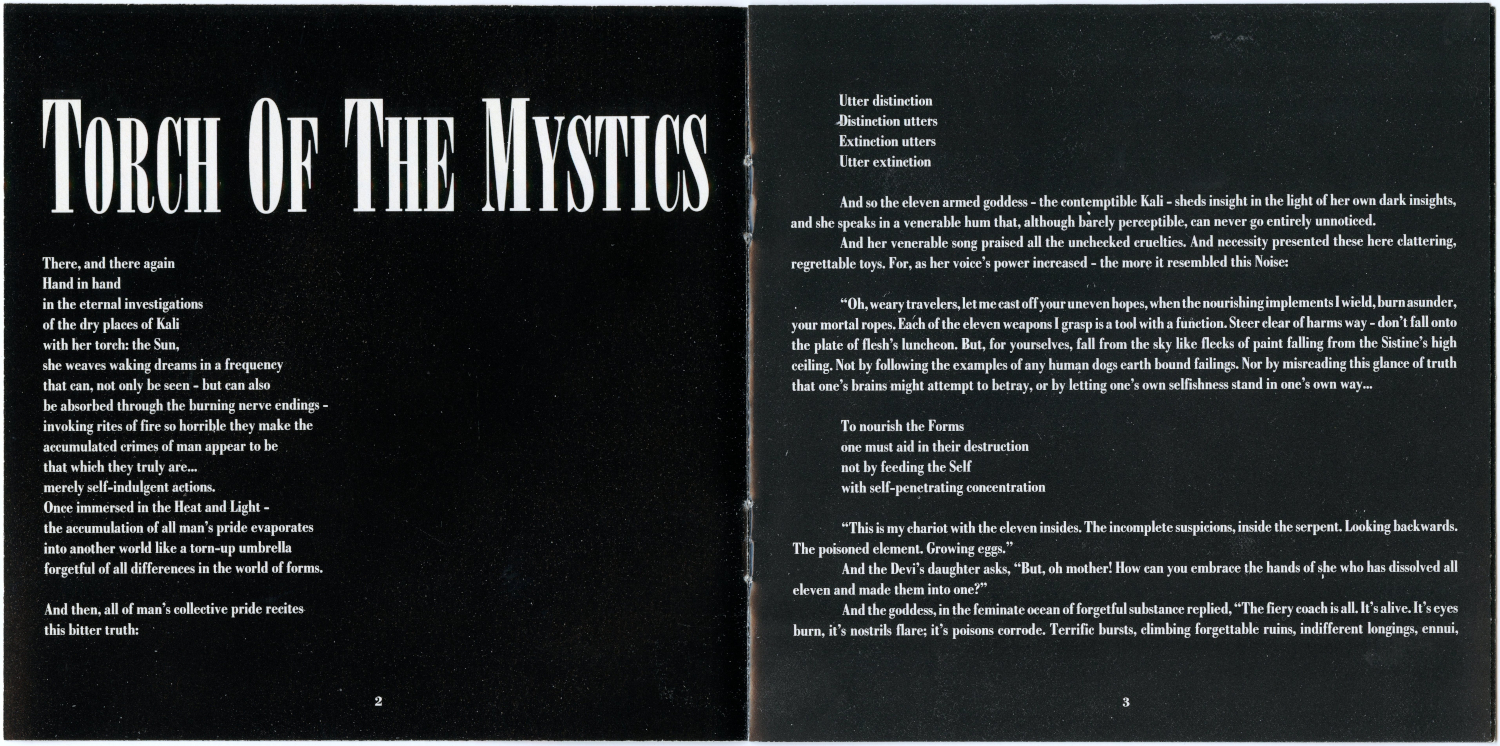
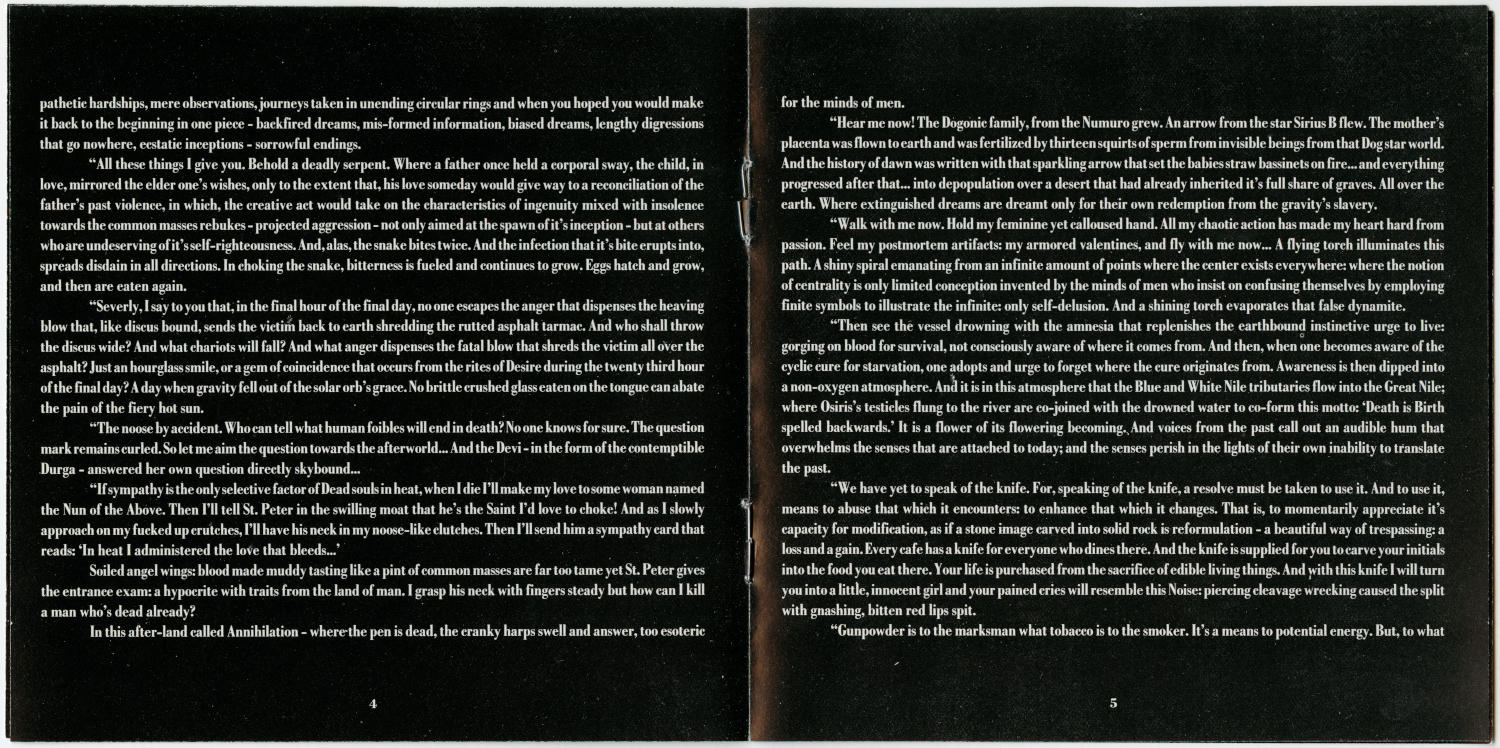
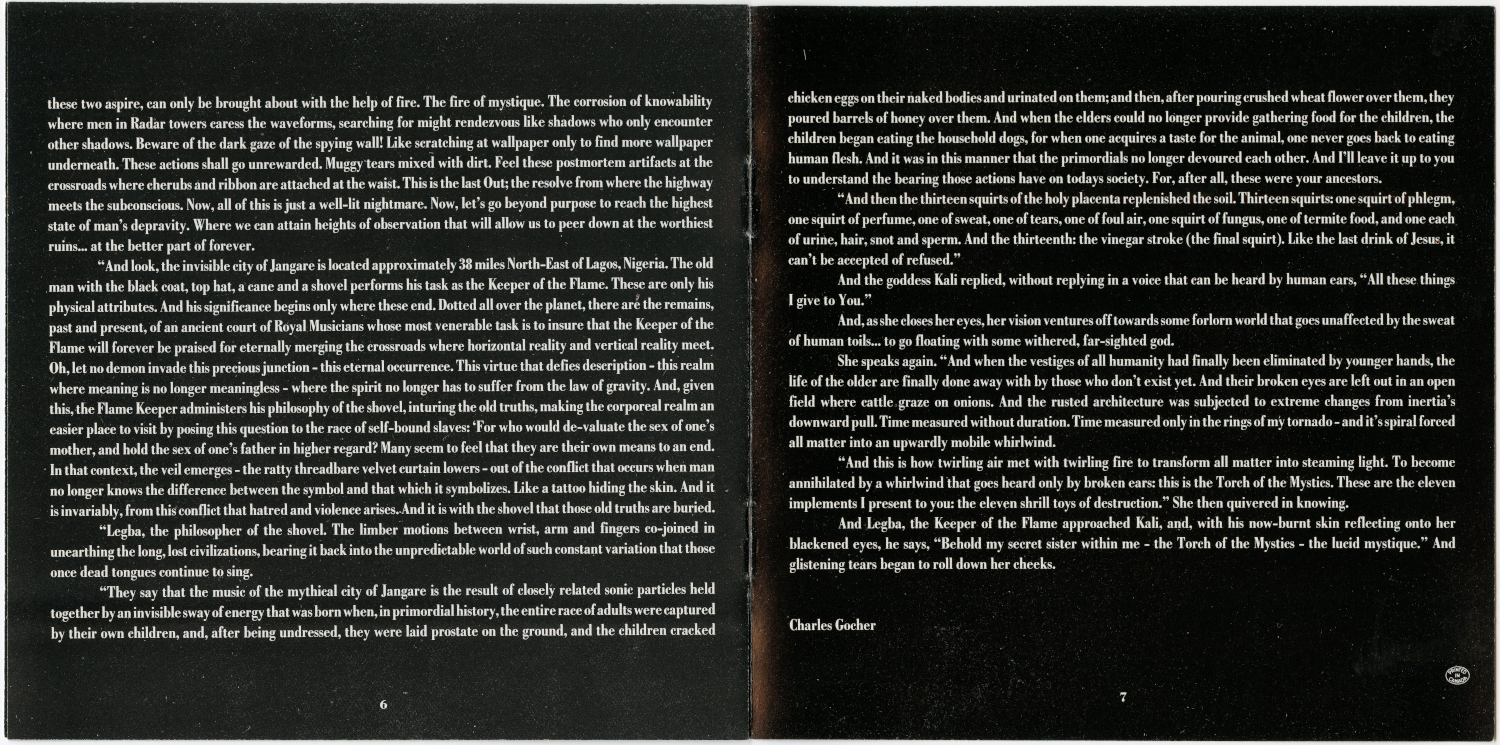
Sun City Girls, Torch of the Mystics
Originally released 1990; reissued 1993 (the booklet above is from this edition) and 2015
Speaking of which.... Several years after first hearing this album, walking into a Montréal subway station, I heard a street musician playing ‘The Shining Path’, sung by Alan on this album. At first, I strained to believe that this random person was a Sun City Girls fan. Of course (while he may have been) most likely he was playing the song because it is not a Sun City Girls original, but one of many instances of them covering, or nearly-completely rearranging, others' songs (disemboweling may better describe Alan's versions of songs like Bob Dylan's ‘Wanted Man’ on the 2017 Alvarius B triple album, With a Beaker on the Burner and an Otter in the Oven). At times, these covers are of folk songs, both traditional or otherwise; ‘The Shining Path’ is a cover of ‘Llorando se Fue’ by the Bolivian group Los Kjarkas.
The Bishop brothers, partially of Lebanese of descent, were introduced to Arabic music and instruments by their father's family during their Michigan childhood. In turn, in league with Gocher, they became deeply interested in Hinduism and Southeast Asian music, including Javanese and Balinese gamelan traditions. The result in the form of Sun City Girls music, when combined with a healthy dose of Southwestern flavors from their later childhood and early-Sun City Girls years in Phoenix (Surf Rock, Latin Rock, and, as already noted, traditional musics from South America) plus Gocher's Jazz-inspired drumming, is a heady mix of styles and compositional methods.
At times, their interpretations of "foreign" musics make sourpusses out of the prudish pseudo-liberal pseudo-intelligentsia whose sensitivities regarding the treatment of racial and ethnic minorities can too often contort into gauche essentializing and reification of our genealogical backgrounds, more K. K. K. than A. C. L. U. To be fair, there are times when Sun City Girls versions of "foreign" work may come off as mere imitations. The thing is, though... their imitations may be the only reason why listeners know about the originals. Only a decade or so after enjoying the band's 2002 album Flute and Mask, especially its extended vocal excursions, often quite theatrical, did I hear examples of Balinese music that actually seemed similar, especially the vocals, namely the album Music of Bali: Barong & Keris Dance, released by Interra Recordings, documenting performances in the village of Batubulan.
The first of three Sun City Girls Singles compilations released after the band's demise, You're Never Alone with a Cigarette, collects the tracks initially considered for a possible double-L. P. configuration of Torch of the Mystics. While a tracking order for this longer version of their classic album was set at the time, Alan has said to me that this sequencing could have changed by the time the proposed double L. P. would have been released. As is, the compilation stands up well enough as a cohesive album, enough to double the size of Torch, if not double the quality. Excluding the brief ‘Harmful Little Armful (For Will Shatter)’, which borders on being a content-less joke track, my 19-track version of a double Torch is as follows:
side A
Blue Mamba
Tarmac 23
Souvenirs from Jangare
Burial in the Sky
Sev Acher
Esoterica of Abyssynia
side B
Space Prophet Dogon
The Shining Path
Amazon One
The Flower
Radar 1941
side C
Plaster Cupids Falling from the Ceiling
The Beauty of Benghazi
Wild World of Animals
100 Pounds of Black Olives
side D
Papa Legba
The Vinegar Stroke
Cafe Batik
The Fine-Tuned Machines of Lemuria
Carnival Folklore Resurrection 7: Libyan Dream, commonly justly recommended as a easy way-in to the difficult Sun City Girls discography, a second selection after Torch, is just-eclectic-enough not to be dismissed as too cohesive to be a brilliant Sun City Girls album. In other words, a great Sun City Girls album is necessarily a little messy, jarring to the listener at times, not letting him get too comfortable. The album starts with a cover of the Amboy Dukes' ‘Journey to the Center of the Mind’, not only better than the original but arguably the epitome of the late-Eighties/ early-Nineties "low-fi" aesthetic. The album then forces the listener through some standard-Girls choppy territory, before heading into gentler terrain, notably a string of non-vocal tracks, from ‘The Vinegar Stroke’ to ‘Sangkala Suite’, that may be as close we can get to having something to offer those who demand boilerplate Sun City Girls, plus the sing-along favorite ‘Opium Den’, the closest the band came to anything that could be considered a hit—if they had deigned to do things like release singles from albums.
Supposedly Libyan Dream was released in 1993 as a cassette, but was "unlabeled and anonymously placed in street tape stands in markets throughout Southeast Asia," as stated at the band's official web site. If it really was completed that year, it can be seen as a culmination of early Sun City Girls music, not only because the band moved to Seattle around that time but also because they soon embarked on albums less Rock-oriented, including soundtrack recordings like Juggernaut. The band's first release on its own label, Abduction Records, Kaliflower, also came out in 1993. Like Libyan Dream, it is accessible by the band's standards, but in my own estimation not as essential as what would soon come.
We should note too, before we get ahead of ourselves, that the switch to Compact Discs released by Abduction brought an end to the band's diverse series, Cloaven Cassettes, released in the years, 1987-1990, and which form another world onto themselves, both a crucial part of the "Cassette Underground" of the Eighties-early Nineties and supplemental documentation of Sun City Girls taking their baby steps, with recordings stretching back to 1982, and performing live. Abduction's founding also indirectly marked the end of series of 7-inch 45 releases, mostly released 1990-1992, some of which (as documented on the aforementioned Sun City Girls Singles reissues) were as excellent as the band's best albums.
With the double-C. D. (later, triple L. P. as well) 330,003 Crossdressers from beyond the Rig Veda, Sun City Girls matched Torch of the Mystics not only in the consistent quality of the music included, but in that the selection of tracks effectively traverses between expected instrumental Rock and experiments in "ethnic" music more likely to feature vocals. Its first-fifth tracks, from ‘Civet's Tango’ to ‘Cruel and Thin’, comprise a brilliant run of songs, with wide disparities in mood, instrumentation, and cultural traditions being drawn upon; as on Torch, these "foreign" excursions offer Alan Bishop's singing at its wondrous, at times bewildering, best. Much of the rest of the album is as good, but looser as it proceeds from brief dips into gamelan music, to a few straight-ahead songs, but mostly to longer, experimental pieces; it may leave the listener unmoored, but pleasantly so. After all, it includes a thirty-four-minute live piece, ‘Ghost Ghat Tresspass/ Sussmeier’, with guest violinist Eyvind Kang that rightly takes it place in the exclusive canon of long-form Rock-based improvisation alongside the likes of Can's ‘Halleluwah’ or numerous versions of Frank Zappa's ‘Black Napkins’ (the half-hour take found in the box-set 40th-anniversary version of Zappa in New York comes to mind, as it also features a star turn from a violinst, Eddie Jobson).
The double-C. D. companion to Crossdressers, Dante's Disneyland Inferno, also released in 1996, sees the band, who usually recorded music in a variety of settings (embracing not only the moment of recording, but whatever particular devices were available) instead working closely with producer Scott Colburn, overdubbing and unafraid to strive for well-rehearsed, meticulously-crafted productions. Indeed, Dante's, apparently not including any live recordings and dominated by vocals and the acoustic guitar, is "cleaner," in terms of sonic fidelity, than any other Girls release. When it comes to its lyrics, though, the album is quite "dirty"—moreover, it is the definitive record, the shining exemplar, of the literary side of Sun City Girls' work. While plenty of Girls fans dislike Dante's, for me it was not only a sister release to Crossdressers, but compares favorably with the latter, so that they can be collectively considered the band's two-pronged masterpiece. Admittedly, Dante's, being just as long as Crossdressers, can also be exhausting.
The bigger reason why it is disliked or ignored is that plenty of Girls fans are quite squeamish about the band's explorations of the profane. As the linguist John McWhorter describes, our understanding of what is offensive in Western civilization has switched over roughly a half-millennium from religious concerns ("damn," "hell") to the scatological and sexual ("fuck," "shit") to the identity-based ("cunt," "nigger"). If this holds, then Sun City Girls can be said to blithely bypass temporal restraints, ensuring that time travelers from the past and future will stand back with mouths agape. Most prominently, we run into Alan's persona/ alter ego Uncle Jim, a recurring feature of Girls albums. Uncle Jim's sociopolitical rants, paired with songs like ‘Soft Fragile Eggshell Minds’, provide the clearest view of the band's overall philosophy. The references to Hindu gods and goddesses; time-jumping, time-oblivious cultural imperialism of the powerful and weak alike; cynical contrarianism morphing into free-for-all, unbridled creativity... these all point to the competition for limited resources that drives humanity to the unspeakable hatred and violence that are our only constant, the only thing we're good at—and good for. These themes continue to be explored in Alan's Alvarius B releases, as well as his band the Invisible Hands, based appropriately enough in Cairo, which in recent years has witnessed humans at their best-worst as much as any other. To be blunt, without listening to Dante's closely and repeatedly, you will miss this larger view of what Sun City Girls offer us. ‘Different Kind of Whore’, from Grotto of Miracles, sums up this perspective another way: “I don't get fucked by Spartan girls/ I get fucked by the world; I don't get fucked by male master spies/ I get fucked right between the eyes.”
On the other hand, Dante's offers moments of sublime beauty, most of all the track, ‘Charles Grocher Sr.’, a loving, if rather oblique, tribute to the drummer's father. It too offers another way of explaining the album's importance to the Sun City Girls worldview. The recited text that, in the track, is accompanied by a bed of clattering percussion, a plaintive organ drone, and a few electronic effects, focuses on reincarnation, summing up: "If you don't believe in the reincarnation of the soul, how do you know that we're not all dead already?" Death, here, can be our physical death, but also intellectual and artistic deaths taking place during our lives, caused by lack of creativity, failures of nerve. The notion of reincarnation, regardless of one's spiritual beliefs or lack thereof, suggests the radical potential of empathy. You can step outside yourself, even become your enemy: the narrator does so in ‘Soft Fragile Eggshell Minds’, taking on the perspective of a murderous, power-hungry villain, and thus understands his evil. And on that note... yes, collect field recordings from across the globe, create collages of them, and release them without proper documentation, as Alan and others would do with their Sublime Frequencies record label. Yes, engage in prank performances as the band famously did in 1994 at San Francisco's Great American Music Hall, sitting on stage telling stories in fake-yokel style; or, as documented in audiovideo, in 2004 at Seattle's Experience Music Project, turning a "high profile" gig into a free-form cacophonous freak show, Alan mockingly sporting an Osama Bin Laden t-shirt. Yes, make inauthentic, inappropriate music. The knowledge gained from such ventures proves necessary. You cannot survive without it.
The back covers of both of these 1996 double C. D.s noted that listeners could send a self-addressed stamped enveloped and receive in turn the lyric sheets for the albums. Alan still sent these out well into the new century, so when I finally gotten around to doing so, more than five years after the albums had come out, the following sheets arrived in the mail. Having the lyrics for at least some of the songs on these albums helps immensely in appreciating them.
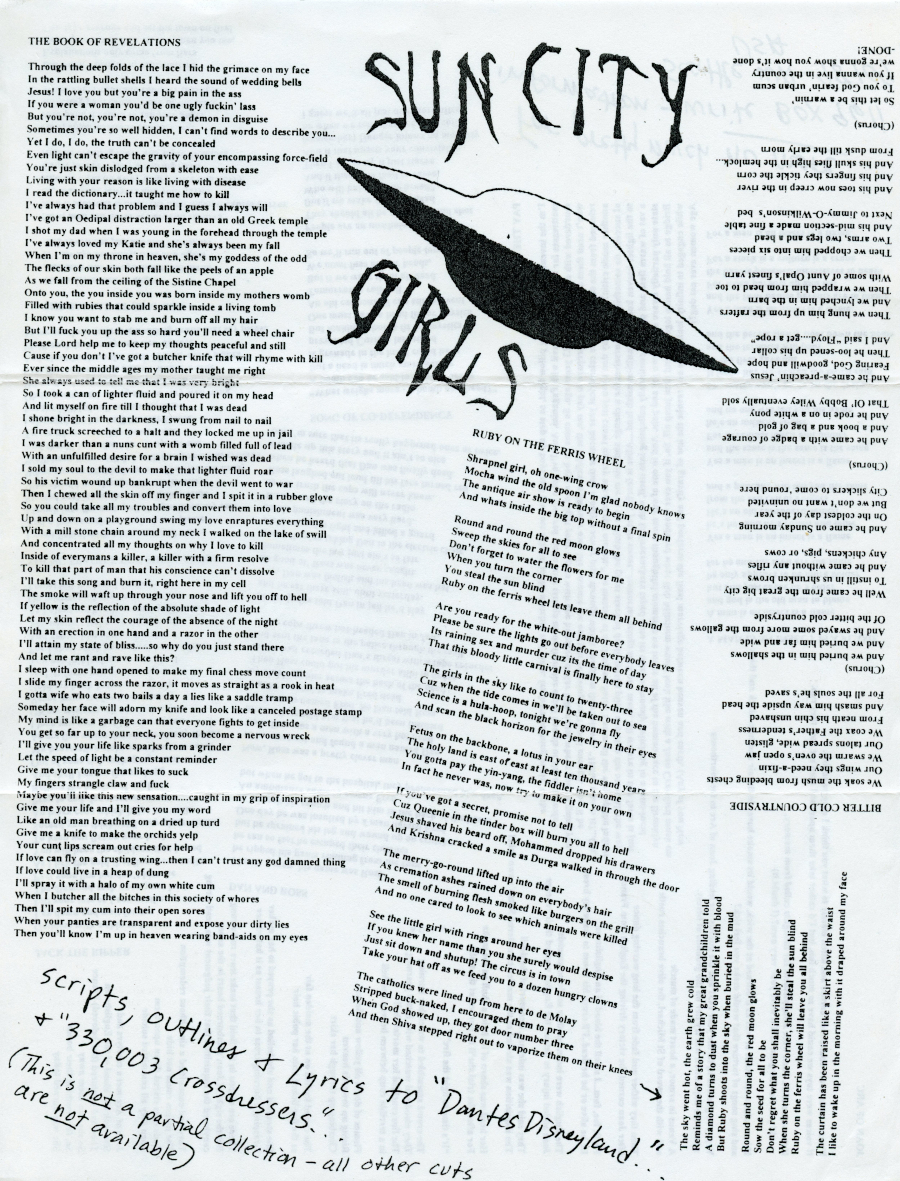
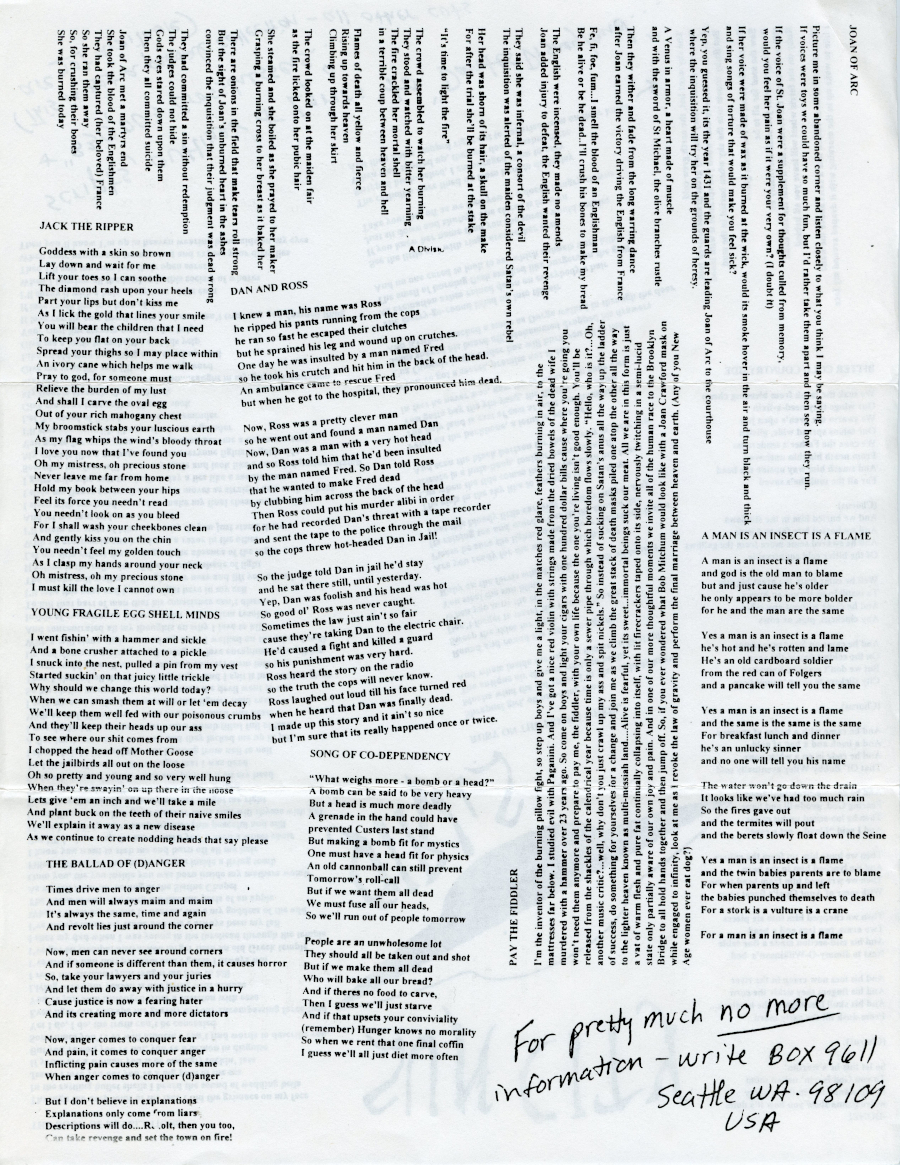
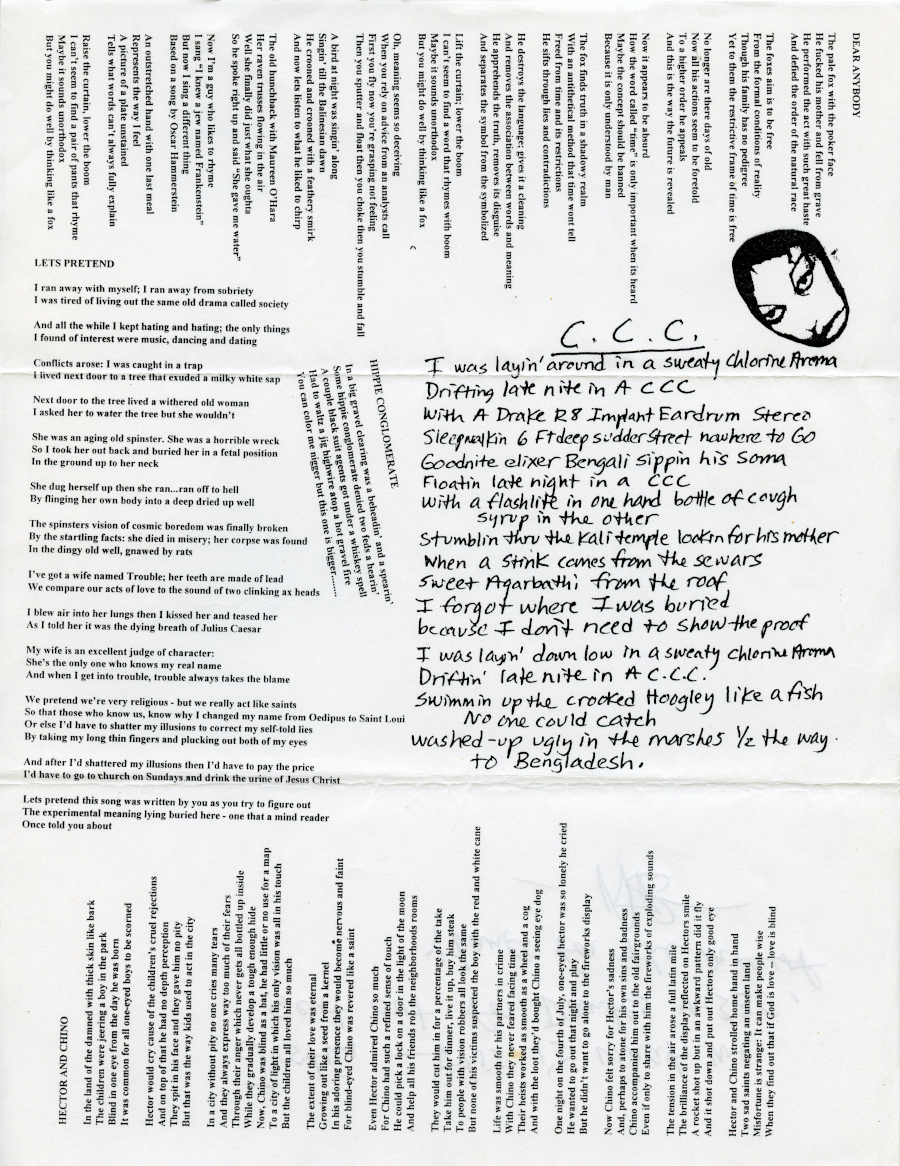
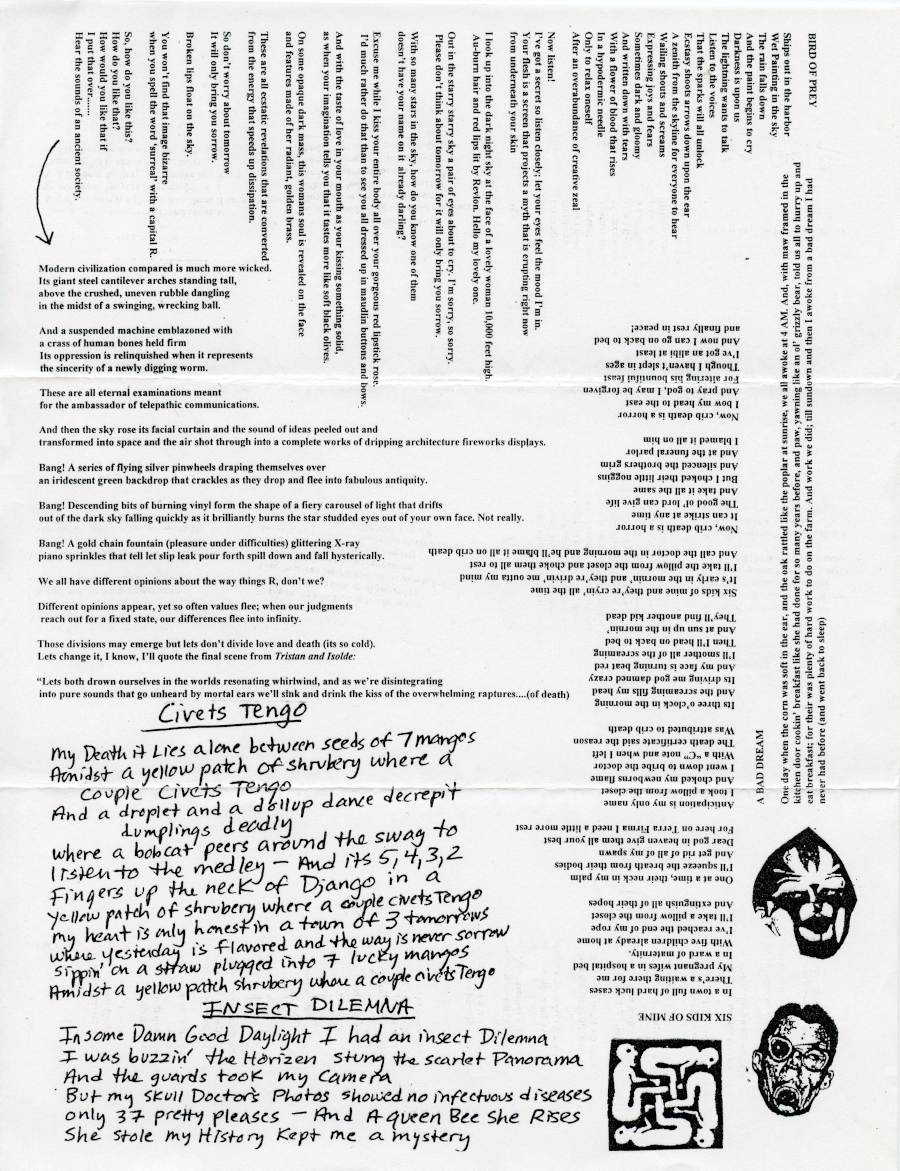
Sun City Girls, when improvising with the standard Rock instrumentation of electric guitar, electric bass guitar, and a drum kit, are a source of numerous pleasures. Marc Masters, author of a broad overview of the band at Pitchfork, concurs, though I must discount his recommendation of Wah, which as a whole is an impressive performance but limited in its timbral palette and hampered by annoying distortion (this album, along Flute and Mask, was originally made available at the merch tables of the band's 2002 tour, a triumphant return to the road after not touring the States since '92). Oddly enough, writers on the band, including myself, have not noted how similar Sun City Girls are to, say, Derek Bailey. Often the band stay within what we could consider the idiom of Rock (again, instrumental Rock songs like those on Torch and Libyan are what is likely to come to mind when one immediately associates "Sun City Girls" with a sound or style of music), as compared to the non-idiomatic improvisation that Bailey defined as central to what is generally called Free Improvisation or Improvised Music. But at other times Sun City Girls definitely leave behind any expectations regarding how their instruments are to be played. Or, rather, they sometimes do so within a performance, exemplarily so on Dawn of the Devi, their follow-up to Torch. (Though unfortunately reissued on L. P., not C. D., in 2019, Dawn of the Devi has found its way to official streaming channels and so thankfully can be heard by the larger audience it deserves.) As with the work of Bailey or the Spontaneous Music Ensemble or later-day Improvised-Music leading lights like the Evan Parker/ Barry Guy/ Paul Lytton trio, in these moments the Bishop brothers and Charles Gocher seem to be a single mind at work on three different instruments. Almost entirely without vocals, Dawn of the Devi provides the best evidence in favor of Masters' claim that the Sun City Girls' improvised Rock is the "molten core of their musical earth." As both Alan and Richard wrote in my Sweet Pea interviews, improvisation has always been fundamental to their art. Other examples of the band jumping from (relatively) standard Rock-instrumental fare into improvised "non-idiomatic" territory are to be heard on the concert recording Carnival Folklore Resurrection 5: Severed Finger with a Wedding Ring
A few other albums that do not make my short list of the band's best, but come awfully close, must include the late-career highlight Djinn Funnel, one of the Girls albums that effectively combines their many streams into an integral whole; it is a raw, live-in-the-room recording but thankfully avoids being an experiment in amplifier-clipping extremes like another fan favorite, Valentines from Matahari. The first entry in the vault-clearing Carnival Folklore Resurrection series, entitled Cameo Demons and Their Manifestations sees the ethnomusicological explorations like those of Flute and Mask creep into relatively-abstract territory. The music on this album seeps into your conscious; initially what sounds brutally minimalist transforms itself in front of your heathen ears into documentation of some sort of imaginary tribal ritual. Another Carnival Folklore entry, the double-disc dual album, High Asia/ Lo-Pacific, is noteworthy. Soundscapes created by field recordings, musique concrète manipulation of such found sounds, and the band's collage-like archival tendencies (as heard on the sprawling three-disc Box of Chameleons) have been at least a minor feature of many Girls releases, going back to their self-titled first L. P. This electroacoustic side of their work became more prominent as their collection of field recordings grew; one hears this on Lo-Asia. Then came the band's "radio" works: the rest of the Carnival Folklore series was devoted to albums actually originally created for radio broadcast, namely Carnival Folklore Resurrection Radio, 98.6 Is Death, and Static from the Outside Set. In these years, Alan and others were releasing similar collage-like works on Sublime Frequencies.
The band's official final studio album, Funeral Mariachi, released posthumously in 2010, received rave reviews from critics and listeners who seemed not to know the band's music well. In fact, much of the album sounds more like an Alvarius B album, especially Baroque Primitiva; and several shorter pieces pass by to little effect. Nonetheless, it does feature a piece of stunning beauty and pathos, ‘Holy Ground’, broaching the elephant in the room, Gocher's death. If you want to win over a Sun City Girls skeptic (an N. P. R.-listening, do-gooder grandma, a grumpy anti-intellect, anti-art American everyman) then play them ‘Holy Ground’ followed by ‘Charles Grocher Sr.’, and shut them up quick.
–Justin J. Kaw, August 2023